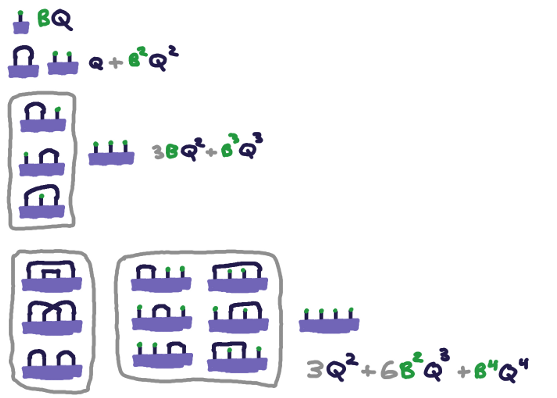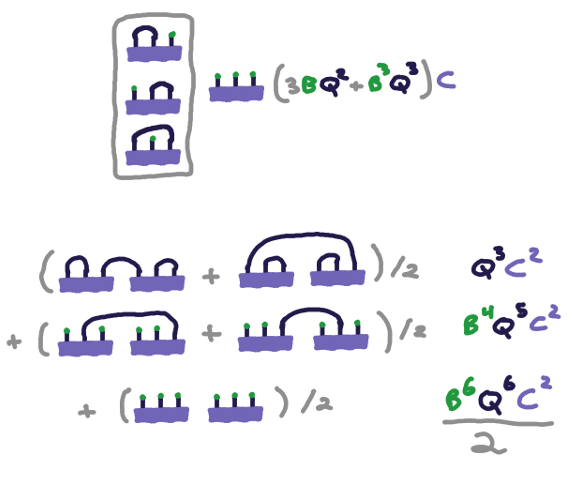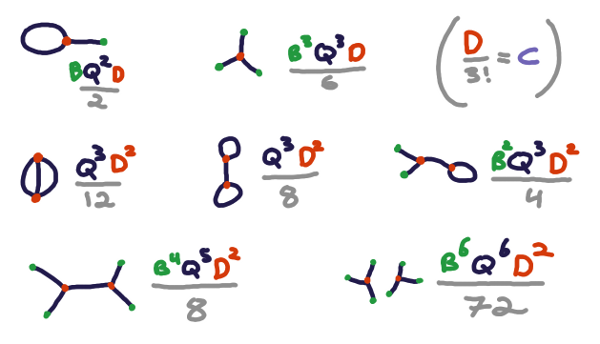
However, we still have that pesky \(Cx^3\) bit there. What do we do about it? Let's think like physicists. The little physicist on our shoulder says: when in doubt, expand as a power series. Our original integral is equal to: \[\int\limits_{-\infty}^\infty e^{-Ax^2 + Bx}\left(\sum_{n=0}^\infty \frac{(Cx^3)^n}{n!} \right)\,dx\] Well, okay, now we've got mere \(x^{3n}\)s where once we had scary \(e^{x^3}\)s. That feels like progress, although we still can't pull this out of the integral because it still involves \(x\). Say... hitting that particlar exponential expression we have there by \(d/dB\) has the same effect as multiplying by \(x\), though. Even if we do it multiple times! That is, \[ (d/dB)^m (e^{-Ax^2 + Bx}) = x^m (e^{-Ax^2 + Bx})\] for any m. Therefore \[\int\limits_{-\infty}^\infty e^{-Ax^2 + Bx}\left(\sum_{n=0}^\infty \frac{(Cx^3)^n}{n!} \right)\,dx = \int\limits_{-\infty}^\infty \sum_{n=0}^\infty\frac{C^n}{n!}(d/dB)^{3n} (e^{-Ax^2 + Bx}) \] and now we can swap the sum and integral and pull all that junk outside the integral sign, since it's all linear and doesn't depend on \(x\). \[=\sum_{n=0}^\infty \frac{C^n}{n!}(d/dB)^{3n}\int\limits_{-\infty}^\infty e^{-Ax^2 + Bx} \] And we can solve the integral we know how to solve: \[= \sum_{n=0}^\infty \frac{C^n}{n!}(d/dB)^{3n} \sqrt{\frac{\pi}{A}} e^{B^2/4A}\] \[=\sqrt{\frac{\pi}{A}} \sum_{n=0}^\infty \frac{C^n}{n!}(d/dB)^{3n} e^{B^2/4A}\] In some sense, we're done now. We could have Mathematica or whatever chug away computing the \(3n^{th}\) derivative of \(e^{B^2/4A}\) and compute this value to whatever accuracy we want, without having to resort to Riemann sums of the original integral, yuck. But let's look closer at what \[ (C^n/n!)(d/dB)^{3n} e^{B^2/4A}\] really means.
Better yet, let's just look at \[ (d/dB)^{m} e^{B^2/4A}\] for the first view values of \(m\).
| \(m\) | \((d/dB)^{m} e^{B^2/4A}\) |
| 0 | \(e^{B^2/4A}\) |
| 1 | \((B/2A) e^{B^2/4A}\) |
| 2 | \((1/2A + B^2/4A^2) e^{B^2/4A}\) |
| \(m\) | \((d/dB)^{m} V\) |
| 0 | \(V\) |
| 1 | \((BQ) V\) |
| 2 | \((Q + B^2Q^2) V\) |
| 3 | \((3BQ^2 + B^3Q^3) V\) |
| 4 | \((3Q^2 + 6B^2Q^3 + B^4Q^4) V\) |
| ... | ... |
| \(m\) | \((d/dB + BQ)^m (1)\) |
| 0 | \(1\) |
| 1 | \(BQ\) |
| 2 | \(Q + B^2Q^2\) |
| 3 | \(3BQ^2 + B^3Q^3\) |
| 4 | \(3Q^2 + 6B^2Q^3 + B^4Q^4\) |
| ... | ... |
Here's a very strange fact: the \(m\)th row of this table is actually giving us a sort of census of wiring diagrams with \(m\) sockets. Watch this:

And now finally we can tell a bit of the story of \[ (C^n/n!)(d/dB)^{3n} e^{B^2/4A}\] It asks for wiring diagrams with multiples of three sockets, and has a symmetry factor of \(1/n!\) that says that rearrangements of the 3-socket groups doesn't matter. Here's a picture of all of the \(C\) contributions to the infinite sum and just a small selection of the \(C^2\)s:

If you're really comfortable with this groupoid cardinality symmetry-factor accounting nonsense, you can decide that you wanted \(C\) to be of the form \(D/3!\) for some 6-fold larger constant \(D\) in the first place, to account for all possible permutations of sockets within a socket-block as well, with the same proviso of more-symmetric diagrams (for this new notion of symmetry) 'counting less'. In that case, the diagrams are more naturally depicted not as wires going into an ordered list of sockets in a block, but as wires freely going into degree-3 vertices in a graph. These are Feynman diagrams! Here's another (nonexhaustive) pile of interesting examples:

And the sum of all of these diagrams, times \(\sqrt{\frac{\pi}{A}} e^{B^2/4A}\), is the value of the integral \[\int\limits_{-\infty}^\infty e^{-Ax^2 + Bx + Cx^3}dx\] that we started with.
...Right? Well, we've been sloppy about treating convergence of anything this whole time. Actually, if \(C\) is positive, then \(e^{Cx^3}\) blows up to infinity in the positive \(x\) direction faster than \(e^{-Ax^2}\) can tame it, and if \(C\) is negative, it blows up in the negative \(x\) direction. I guess this might have something to do with why many textbooks I've seen treat "the \(\phi^4\) theory" rather than the "the \(\phi^3\)"? I'm not actually sure. Anyhow, I could make a convergent integral by having \(-x^4\) in there instead of \(x^3\), and then there would be degree-4 vertices instead of degree-3.
It seems to my gut sense strangely likely that the infinite series of diagrams should converge, however, even for the degree-3 case, as long as \(D\) is small. But maybe I'm wrong about that, and the combinatorial explosion of graphs grows faster than increasing powers of \(D\).